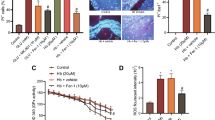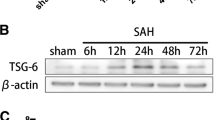Abstract
Early brain injury (EBI) following subarachnoid hemorrhage (SAH) is characterized by rapid development of neuron apoptosis and dysregulated inflammatory response. Microglia efferocytosis plays a critical role in the clearance of apoptotic cells, attenuation of inflammation, and minimizing brain injury in various pathological conditions. Here, using a mouse SAH model, we aim to investigate whether microglia efferocytosis is involved in post-SAH inflammation and to determine the underlying signaling pathway. We hypothesized that TAM receptors and their ligands regulate this process. To prove our hypothesis, the expression and cellular location of TAM (Tyro3, Axl, and Mertk) receptors and their ligands growth arrest-specific 6 (Gas6) and Protein S (ProS1) were examined by PCR, western blots, and fluorescence immunostaining. Thirty minutes after SAH, mice received an intraventricular injection of recombinant Gas6 (rGas6) or recombinant ProS1 (rPros1) and underwent evaluations of inflammatory mediator expression, neurological deficits, and blood–brain barrier integrity at 24 h. Microglia efferocytosis of apoptotic neurons was analyzed in vivo and in vitro. The potential mechanism was determined by inhibiting or knocking down TAM receptors and Rac1 by specific inhibitors or siRNA. SAH induced upregulation of Axl and its ligand Gas6. The administration of rGas6 but not rPros1 promoted microglia efferocytosis, alleviated inflammation, and ameliorated SAH-induced BBB breakdown and neurological deficits. The beneficial effects of rGas6 were arrogated by inhibiting or knocking down Axl and Rac1. We concluded that rGas6 attenuated the development of early brain injury in mice after SAH by facilitating microglia efferocytosis and preventing inflammatory response, which is partly dependent on activation of Axl and Rac1.









Similar content being viewed by others

Data Availability
The original contributions presented in the study are included in the article/supplementary material. Further inquiries can be directed to the corresponding author.
Change history
08 April 2024
A Correction to this paper has been published: https://doi.org/10.1007/s12975-024-01246-9
References
Neifert SN, Chapman EK, Martini ML, Shuman WH, Schupper AJ, Oermann EK, et al. Aneurysmal subarachnoid hemorrhage: the last decade. Transl Stroke Res. 2021;12:428–46.
Cai W, Dai X, Chen J, Zhao J, Xu M, Zhang L, et al. Stat6/arg1 promotes microglia/macrophage efferocytosis and inflammation resolution in stroke mice. JCI Insight. 2019;4:e131355.
Marquez-Ropero M, Benito E, Plaza-Zabala A, Sierra A. Microglial corpse clearance: lessons from macrophages. Front Immunol. 2020;11:506.
Lyu J, Jiang X, Leak RK, Shi Y, Hu X, Chen J. Microglial responses to brain injury and disease: functional diversity and new opportunities. Transl Stroke Res. 2021;12:474–95.
Myers KV, Amend SR, Pienta KJ. Targeting Tyro3, Axl and MerTK (TAM receptors): implications for macrophages in the tumor microenvironment. Mol Cancer. 2019;18:94.
Miner JJ, Daniels BP, Shrestha B, Proenca-Modena JL, Lew ED, Lazear HM, et al. The TAM receptor Mertk protects against neuroinvasive viral infection by maintaining blood-brain barrier integrity. Nat Med. 2015;21:1464–72.
Wu G, McBride DW, Zhang JH. Axl activation attenuates neuroinflammation by inhibiting the tlr/traf/nf-kappab pathway after MCAO in rats. Neurobiol Dis. 2018;110:59–67.
Anderson SR, Roberts JM, Ghena N, Irvin EA, Schwakopf J, Cooperstein IB, et al. Neuronal apoptosis drives remodeling states of microglia and shifts in survival pathway dependence. Elife. 2022;11
Tang J, Hu Q, Chen Y, Liu F, Zheng Y, Tang J, et al. Neuroprotective role of an n-acetyl serotonin derivative via activation of tropomyosin-related kinase receptor b after subarachnoid hemorrhage in a rat model. Neurobiol Dis. 2015;78:126–33.
Xiao ZP, Lv T, Hou PP, Manaenko A, Liu Y, Jin Y, et al. Sirtuin 5-mediated lysine desuccinylation protects mitochondrial metabolism following subarachnoid hemorrhage in mice. Stroke. 2021;52:4043–53.
Gruber RC, Ray AK, Johndrow CT, Guzik H, Burek D, de Frutos PG, et al. Targeted GAS6 delivery to the CNS protects axons from damage during experimental autoimmune encephalomyelitis. J Neurosci. 2014;34:16320–35.
Zhang JS, Hou PP, Shao S, Manaenko A, Xiao ZP, Chen Y, et al. Microrna-455-5p alleviates neuroinflammation in cerebral ischemia/reperfusion injury. Neural Regen Res. 2022;17:1769–75.
Wang JJ, Liu F, Yang F, Wang YZ, Qi X, Li Y, et al. Disruption of auto-inhibition underlies conformational signaling of asic1a to induce neuronal necroptosis. Nat Commun. 2020;11:475.
van der Meer JH, van der Poll T, van 't Veer C. Tam receptors, gas6, and protein s: roles in inflammation and hemostasis. Blood. 2014;123:2460–2469.
Yin C, Heit B. Cellular responses to the efferocytosis of apoptotic cells. Front Immunol. 2021;12:631714.
Hu M, Lin Y, Men X, Wang S, Sun X, Zhu Q, et al. High-salt diet downregulates TREM2 expression and blunts efferocytosis of macrophages after acute ischemic stroke. J Neuroinflammation. 2021;18:90.
Zhang Y, Chen K, Sloan SA, Bennett ML, Scholze AR, O’Keeffe S, et al. An RNA-sequencing transcriptome and splicing database of glia, neurons, and vascular cells of the cerebral cortex. J Neurosci. 2014;34:11929–47.
Fourgeaud L, Traves PG, Tufail Y, Leal-Bailey H, Lew ED, Burrola PG, et al. Tam receptors regulate multiple features of microglial physiology. Nature. 2016;532:240–4.
Weinger JG, Brosnan CF, Loudig O, Goldberg MF, Macian F, Arnett HA, et al. Loss of the receptor tyrosine kinase Axl leads to enhanced inflammation in the CNS and delayed removal of myelin debris during experimental autoimmune encephalomyelitis. J Neuroinflammation. 2011;8:49.
Binder MD, Cate HS, Prieto AL, Kemper D, Butzkueven H, Gresle MM, et al. Gas6 deficiency increases oligodendrocyte loss and microglial activation in response to cuprizone-induced demyelination. J Neurosci. 2008;28:5195–206.
Geng K, Kumar S, Kimani SG, Kholodovych V, Kasikara C, Mizuno K, et al. Requirement of gamma-carboxyglutamic acid modification and phosphatidylserine binding for the activation of Tyro3, Axl, and Mertk receptors by growth arrest-specific 6. Front Immunol. 2017;8:1521.
McCubbrey AL, McManus SA, McClendon JD, Thomas SM, Chatwin HB, Reisz JA, et al. Polyamine import and accumulation causes immunomodulation in macrophages engulfing apoptotic cells. Cell Rep. 2022;38:110222.
Han J, Bae J, Choi CY, Choi SP, Kang HS, Jo EK, et al. Autophagy induced by Axl receptor tyrosine kinase alleviates acute liver injury via inhibition of NLRP3 inflammasome activation in mice. Autophagy. 2016;12:2326–43.
Abu-Thuraia A, Gauthier R, Chidiac R, Fukui Y, Screaton RA, Gratton JP, et al. Axl phosphorylates Elmo scaffold proteins to promote Rac activation and cell invasion. Mol Cell Biol. 2015;35:76–87.
Dransfield I, Zagorska A, Lew ED, Michail K, Lemke G. Mer receptor tyrosine kinase mediates both tethering and phagocytosis of apoptotic cells. Cell Death Dis. 2015;6:e1646.
Zhang W, Zhao J, Wang R, Jiang M, Ye Q, Smith AD, et al. Macrophages reprogram after ischemic stroke and promote efferocytosis and inflammation resolution in the mouse brain. CNS Neurosci Ther. 2019;25:1329–42.
Yagami T, Ueda K, Asakura K, Sakaeda T, Nakazato H, Kuroda T, et al. Gas6 rescues cortical neurons from amyloid beta protein-induced apoptosis. Neuropharmacology. 2002;43:1289–96.
Yagami T, Ueda K, Asakura K, Okamura N, Sakaeda T, Sakaguchi G, et al. Effect of gas6 on secretory phospholipase a(2)-iia-induced apoptosis in cortical neurons. Brain Res. 2003;985:142–9.
Zhou H, Hu L, Li J, Ruan W, Cao Y, Zhuang J, et al. Axl kinase-mediated astrocytic phagocytosis modulates outcomes of traumatic brain injury. J Neuroinflammation. 2021;18:154.
Funding
This research was supported by grants from the National Natural Science Foundation of China No. 82071283 to Qin Hu, No. 81601013 to Junjia Tang, No. 31900686 to Jianfei Lu, and No. 82271310 to Feng Jia, the Natural Science Foundation of Shanghai 22ZR1437700 to Qin Hu, and Science and Technology Commission of Shanghai Municipal 21ZR1439000 to Feng Jia.
Author information
Authors and Affiliations
Contributions
JT, JL, YJ, and QH conceived and designed the study. JT and TL performed animal models and behavioral tests, and L-FZ and XQ did the in vitro microglia efferocytosis experiment. YJ and ZZ collected the samples and run PCR and western blots. JL, BZ, and JT performed the histology and immunostaining. JL, XZ, and QH analyzed the data and finalized the figures. FJ, AM, JHZ, and QH wrote the manuscript. All the authors revised and approved the final version of the manuscript.
Corresponding authors
Ethics declarations
Ethics Approval and Consent to Participate
All experimental procedures involving animals were approved by the Ren Ji Hospital Animal Care and Use Committee and were performed in accordance with the guidelines in the National Institutes of Health (NIH) Guide for the Care and Use of Laboratory Animals and followed the ARRIVE guidelines. This article does not contain any studies with human participants performed by any of the authors.
Consent for Publication
The manuscript is approved by all authors for publication.
Conflict of Interest
The authors declare no competing interests.
Additional information
Publisher's Note
Springer Nature remains neutral with regard to jurisdictional claims in published maps and institutional affiliations.
Supplementary Information
Below is the link to the electronic supplementary material.
Rights and permissions
Springer Nature or its licensor (e.g. a society or other partner) holds exclusive rights to this article under a publishing agreement with the author(s) or other rightsholder(s); author self-archiving of the accepted manuscript version of this article is solely governed by the terms of such publishing agreement and applicable law.
About this article
Cite this article
Tang, J., Jin, Y., Jia, F. et al. Gas6 Promotes Microglia Efferocytosis and Suppresses Inflammation Through Activating Axl/Rac1 Signaling in Subarachnoid Hemorrhage Mice. Transl. Stroke Res. 14, 955–969 (2023). https://doi.org/10.1007/s12975-022-01099-0
Received:
Revised:
Accepted:
Published:
Issue Date:
DOI: https://doi.org/10.1007/s12975-022-01099-0



